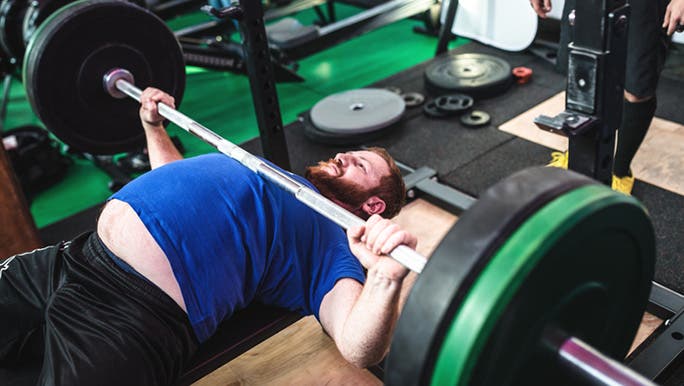Healthy habits for men to help reduce belly fat

Key Points
- Belly fat and waist circumference may impact your health
- Two key types of fat are subcutaneous and visceral fat
- Visceral fat is more of a concern as it surrounds vital organs
- You can reduce belly fat by adopting healthier habits
There’s a lot of chatter in the wellness world about belly fat. And unfortunately, it’s not all based on science – especially some of the misinformation you can read online, which is often unsubstantiated.
For example, targeted fat loss or spot reduction doesn’t work, so doing a bunch of abdominal crunches in the hope of losing belly fat is misguided and measurements like BMI aren’t always as telling as we once thought they were.
That said, waist circumference can be associated with an increased risk of chronic disease. We spoke to Accredited Practising Dietitian Kate Agnew about the recommended ways for men to lose belly fat and why losing some may be beneficial.
But first, let’s get a clearer understanding of the different types of fat.
Types of fat
You may or may not know that all body fat is not the same. Two key types include:
- subcutaneous fat – which sits under the skin (the type you can usually see or pinch)
- visceral fat – surrounds vital organs like the liver and heart
“It’s the visceral fat that’s more of a concern, as it surrounds our vital organs like our liver and heart,” Kate says.

Men who are exploring ways to lose belly fat need to visit a GP for an assessment
Why is waist circumference important?
Interestingly, research suggests that weight carried around your middle is more impactful on your health than any overall extra weight you may be carrying.
Why? Because belly fat is more likely to be visceral fat: the one that’s not great for our general health.
“It can increase the risk of chronic disease, particularly heart disease and diabetes,” Kate says. “And some studies have shown that extra visceral fat can also disrupt the normal functioning of hormones in the body.”
According to Kate, men who are exploring how to lose belly fat should first get some objective measure of how their waist circumference might be affecting their health.
You can measure your waist at home using this guide, but for the most accurate reading, visit your healthcare professional. It’s also wise to have your cholesterol and blood pressure checked while you’re there.

Australian Government guidelines state a waist circumference greater than 94cm for Caucasian males may increase the risk of disease
What is a healthy waist circumference for men?
Who’s ready for some men’s health facts?
Australian Government guidelines state that a waist circumference greater than 94cm for Caucasian males increases the risk of chronic disease. A waist circumference of greater than 90cm for Asian, Chinese and Japanese men is associated with a risk of metabolic complications. For men not of European descent, such as Pacific Islanders, thresholds may be higher, however this has not been determined.
There are many non-lifestyle factors like:
- age
- gender
- genetics
Lifestyle factors like the following can also influence belly fat:
- nutrition
- alcohol consumption
- exercise
- sleep
“There are healthy habits that men can take on board to reduce their chances of having a higher waist circumference,” Kate says. (We’ll get to these shortly.)
Managing your waist circumference is important because, remember, visceral fat may increase the risk of chronic diseases like heart disease and diabetes.
So, let’s take a look at a major lifestyle factor: physical exercise.

Performing muscle-strengthening exercises twice a week is recommended
Physical guidelines recommendations
There’s no doubt that exercise is good for you, no matter your motivation. Men’s mental health, physical health and social connections can all benefit from doing more exercise.
According to current physical activity guidelines for adults, each week you should:
- be active on most days, if not all
- do 150-300 minutes of moderate-intensity physical activity or 75-150 minutes of vigorous-intensity physical activity
- perform muscle-strengthening exercises twice a week
“But most importantly, you should do movement that you enjoy every day as part of a healthy, balanced lifestyle,” Kate says. “As healthcare professionals, we don’t want people to jump on the exercise bandwagon, drop a bunch of weight and then stop.”
Consistency is key.
But Kate points out that losing belly fat for men is much more complex than just exercising. It’s important to adopt a range of healthy habits.
Guys and abs: how hard is it to get a sixpack?
Like many men, at some point you may have wanted to know how to reduce belly fat so you can have a sixpack. Well, there’s a reason they’re much more common among teenagers than grown men.
“Unless you have a very low body-fat percentage, your abs are not going to be visible,” Kate says.
Kate also points out that aiming for a sixpack may not be the healthiest goal.
“We all need fat,” she says. “Fat’s really important as an energy store – to keep you warm and your hormones functioning properly.”
Healthier habits you can adopt
So when it comes to shifting belly fat,what should the goal be?
According to Kate, when you focus on adopting a healthier lifestyle, an improvement in your belly fat should likely follow.
You can start living a healthier lifestyle in the following ways:
- Limit your alcohol intake to a maximum of ten standard drinks per week, in line with the Australian guidelines.
- Eat a balanced diet, including 5-6 serves of vegetables each day (something only 1 in 25 Aussie men currently do).
- Every day, do some sort of movement that you enjoy.
- Aim for 7-9 hours of sleep every night. This can help your metabolism, hormones and general wellbeing.
It’s a cliche, but you’re more than a number
Don’t forget, there are many different ways to measure health. Building healthier habits and enjoying a sustainable lifestyle that makes you feel good should be your number one goal.
Need some support? Explore our 7-day life’s better program.
If you suspect you may be struggling with an eating disorder, speak to your GP or talk to someone from the Butterfly Foundation on 1800 334 673.
Related:
- Your heart and exercise: how they work together
- How to set and keep effective fitness goals
- How to stay active (and why it matters) with Sam Wood
Kate Agnew is an Accredited Practising Dietitian who is passionate about innovation and problem-solving in health and nutrition. Her goal is to ultimately create a healthier environment for all Australians.
Reviewed by the healthylife Advisory Board December 2022.
This article is for informational purposes only and does not provide medical advice, diagnosis or treatment. Any information published on this website or by this brand is not intended as a substitute for medical advice. If you have any concerns or questions about your health, you should consult with a healthcare professional.